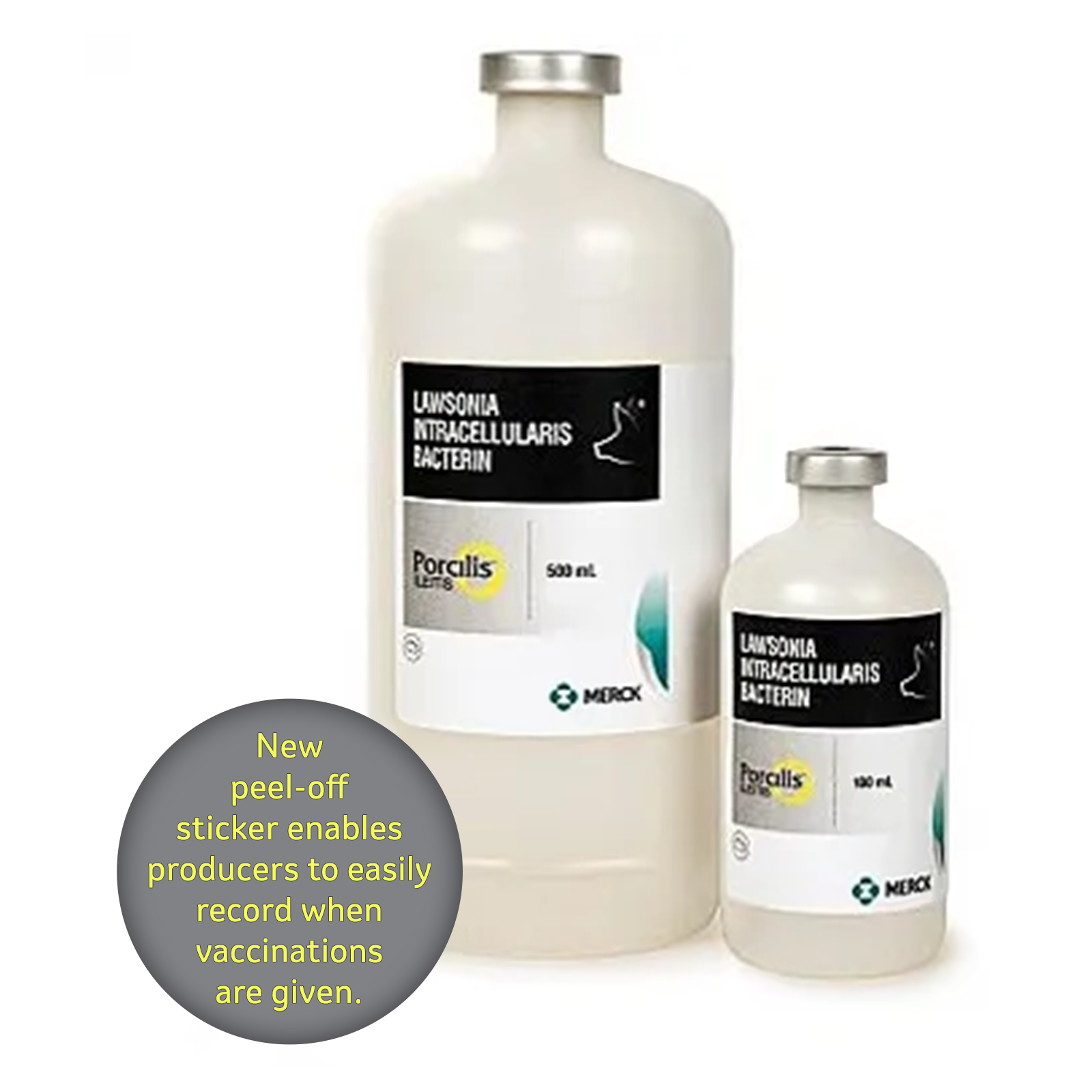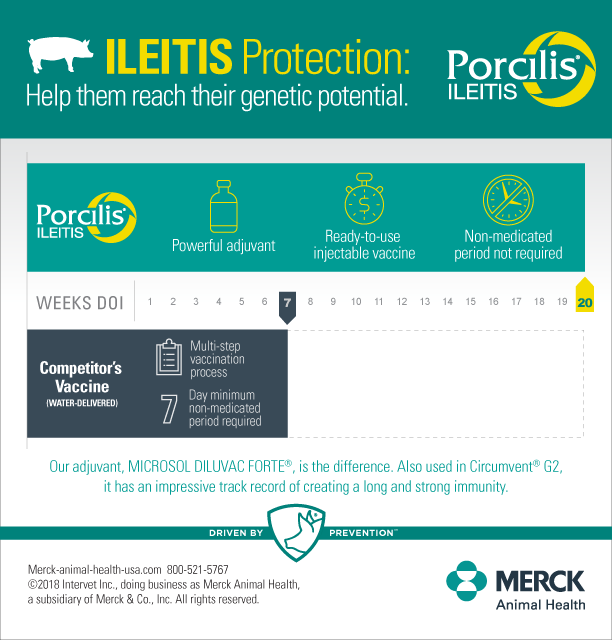PORCILIS® ILEITIS
Lawsonia Intracellularis Bacterin
For use in healthy swine as an aid in the control of ileitis caused by Lawsonia intracellularis, an aid in the reduction of colonization by Lawsonia and an aid in the reduction of duration of fecal shedding. Duration of immunity for at least 20 weeks has been demonstrated.


Indications
For use in healthy swine as an aid in the control of ileitis caused by Lawsonia intracellularis, an aid in the reduction of colonization by Lawsonia and an aid in the reduction of duration of fecal shedding. Duration of immunity for at least 20 weeks has been demonstrated.
Product Information
Porcilis Ileitis offers long-lasting protection for ileitis control.
- Industry-leading 20-week (five months) duration of immunity (DOI)
- With a 20-week DOI, vaccination with Porcilis Ileitis provides 13 more weeks of protection than the water-administered vaccine on the market
- One-dose, ready-to-use injectable vaccine
- As the only injectable vaccine available for ileitis, Porcilis Ileitis allows for vaccination of pigs at 3 weeks of age or older – an age when they’re easier to handle
- A single-bottle vaccine means no mixing, combining or risk of contamination from the process
- No worrying about removing feed-grade antibiotics during vaccination
Administration and Dosage
Shake well. Warm the vaccine to room temperature immediately prior to administration. Using aseptic technique, inject 2 mL once intramuscularly (IM) into pigs at 3 weeks of age or older.
Downloads
Technical Information
In today’s modern swine production systems, ileitis continues to be a problem and its impact in reducing pig performance can be a tremendous drain on profitability. Merck Animal Health now offers the first injectable vaccine in your fight against ileitis.
A challenge study showed that Porcilis Ileitis is effective for at least 20 weeks after vaccination. Specifically, it:
- Induced Lawsonia intracellularis antibody titers
- Controlled ileitis lesions, both gross and microscopic
- Reduced colonization of L. intracellularis
- Reduced duration of fecal shedding
The proof? Longest duration of immunity on the market – 20 weeks.
About Ileitis
Common and costly, ileitis continues to cause production variation within groups of finishing pigs. It’s responsible for poor feed conversion and a 6-20% reduction in average daily gain, which means increased days to market and increased end weight variation. Affected operations also see an increased number of culls and high mortality.
Also known as porcine proliferative enteropathy, this disease is caused by the bacterium Lawsonia intracellularis, which lives inside the cells of the intestinal lining. L. intracellularis can cause a number of harmful changes to the small intestine. This means nutrients are not absorbed properly and performance suffers.
Chronic/Subclinical Ileitis
Chronic ileitis typically occurs after weaning or between 6 and 20 weeks of age. Clinical signs are often slight, including soft, watery and/or pasty diarrhea, or the disease can be subclinical, which means that there are no overt signs of disease.
The most prevalent sign of subclinical ileitis is a variation in performance and failure of part of the group to sustain growth despite normal feed intake. Pigs may be eating normally but they are growing slowly, and feed efficiency is negatively impacted. It has been reported that ileitis can slash average daily gain by 38% and feed efficiency by 27%.1
Stress, from things like weather and moving or commingling pigs, may cause a subclinical infection to become clinical.
Studies found that nearly 42% of grow/finish operations reported clinical ileitis and nearly 94% of herds with no clinical signs were found to have subclinical ileitis.2,3
Acute Ileitis
Acute ileitis tends to be a hemorrhagic form of the disease and commonly occurs in young adults. Replacement gilts and young boars are the most likely animals to show signs of disease. Black, tarry feces is often the first clinical sign. Some animals die quickly without any changes in fecal consistency or appearance and only show extreme paleness due to blood loss into the lumen of the bowel. Around 50% of pigs affected with acute ileitis will die, with the remaining recovering in a few weeks.
Disease Transmission
This disease is primarily transmitted through fecal shedding and has a high transmission rate. Even subclinically infected pigs can shed the organism.4
Pigs can shed the organism for up to 12 weeks after clinical signs have abated.
Cost of Ileitis
The financial impact of ileitis varies widely depending upon the prevalence of concurrent diseases, sanitation and drying between groups of pigs, and inconsistent feed intake. It is estimated that this disease costs producers somewhere between $2.73 and $19.76 per pig in the U.S. annually. 5
For additional information, please see the product label.
References:
1. Paradis M.A., McKay R.I., Wilson J.B., Vessie G.H., Winkelman N.L. and Gebhart C.J. Subclinical ileitis produced by sequential dilutions of Lawsonia intracellularis in a mucosal homogenate challenge model. Proceedings of the 36th Annual Meeting of the American Association of Swine Veterinarians. 2005.
2. USDA. 2007. Swine 2006, Part II: Reference of Swine Health and Health Management Practices in the United States, 2006. USDA:APHIS:VS, CEAH. Fort Collins, CO. #N479.1207
3. Armbruster G.A., Deen J., Gebhart C.J., Pelger G.A., Keffaber K.K. and Parks C.W. Review of Lawsonia intracellularis seroprevalence screening in the United States, June 2003 to July 2006. Proceedings of the 38th Annual Meeting of the American Association of Swine Veterinarians. 2007.
4. Guedes R. Update on epidemiology and diagnosis of porcine proliferative enteropathy. J Swine Health Prod. 2004; 12(3):134-138.
5. Veenhuizen, M.F., Elam, T.E. and Soenksen N. The potential economic impact of porcine proliferative enteropathy on the US swine industry. In Proceedings of the Congress of the 15th International Pig Veterinary Society 1998; 64.

